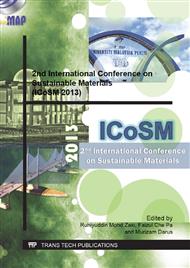p.47
p.51
p.56
p.60
p.64
p.69
p.74
p.78
p.82
Void Content Determination of Fiber Reinforced Polymers by Acid Digestion Method
Abstract:
Porosity of the fiber-reinforced polymer (FRP) is one of very important quality characteristics for the advanced use of the material in order to ensure full performance properties are attained. It was found that the porosity values of FRP in typical aircraft composite parts must be lower than 2.5 % to achieve the required mechanical properties. The most common method for measuring the void content is through acid digestion testing or burn-off method, since it provides the true values that could be used to generate the database properties of the materials. Thus, this paper discussed the detail of the acid digestion test procedures for the void content measurement of FRP, especially with regards to the suitable testing time and chemical volumetric quantity required to ensure the matrix of test sample has been completely extracted. In order to attain this, different test samples for different processing techniques were prepared. Subsequently, the findings were discussed within the context of void content in cured monolithic composite for different types of process, in which the samples from the VBO-oven curing process were compared with those of the autoclave-cured samples. In the VBO-oven curing process, the use of an intensifier during the curing provided higher void content of 15.52% in comparison with those achieved through the debulking process (10.91%). It has been clearly observed that the debulking produced a substantial effect towards the air evacuation mechanism within the laminate.
Info:
Periodical:
Pages:
64-68
Citation:
Online since:
September 2013
Authors:
Price:
Сopyright:
© 2013 Trans Tech Publications Ltd. All Rights Reserved
Share:
Citation:


